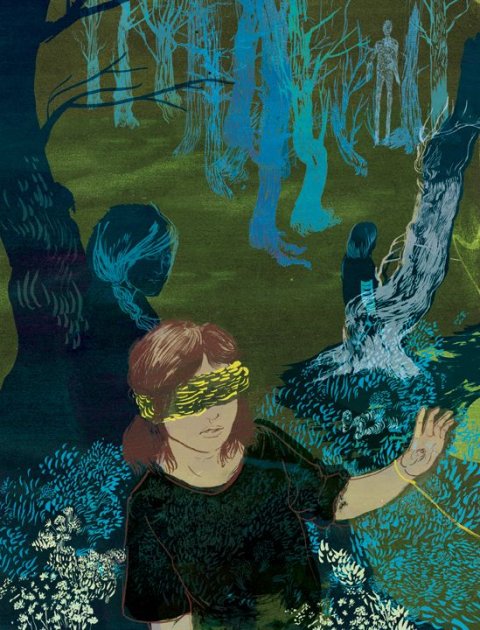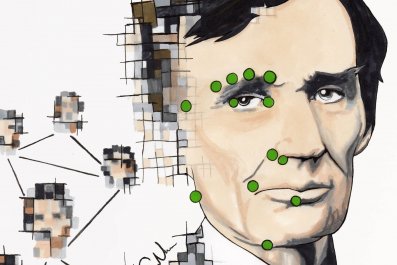This is a tale of a young friendship gone horribly wrong. In late May, in the Milwaukee suburb of Waukesha, Wisconsin, two 12-year-old girls allegedly lured a friend into the woods and stabbed her 19 times. The victim, also 12, managed to crawl to a road, where she lay on the sidewalk with stab wounds in her arms, legs and torso, blood soaking her black fleece jacket, until a bicyclist found her and called 911. According to police, the assailants had been plotting the crime for months. Their motivation? They said they wanted to prove themselves worthy of Slender Man, an evil character who lives only on the Internet.
It sounds like the outlandish plot of a horror movie, in part because it is incredibly rare for young girls to murder. In 2012, of the 8,514 people arrested for murder and nonnegligent homicide in the U.S., just one was a girl under the age of 13. It's not so surprising, then, that when girls do kill, their crimes often devolve into sensationalized pop culture narratives, replete with simplistic explanations and groundless moralizing. "This should be a wake-up call for all parents," Waukesha Police Chief Russell Jack said in a much-quoted statement about his two young prisoners. "The Internet has changed the way we live. It is full of information and wonderful sites that teach and entertain. The Internet can also be full of dark and wicked things."
Diluted advice to parents and ill-informed attempts at making sense of this case won't get us far. We do not know enough about the two girls' mental states, friendship, families and backgrounds to generalize about their motivations. And their act is so unusual that it tells us little about our daughters.
We do know about fear, however, and a rising cultural panic this case seems to encapsulate. The response to what these girls are accused of doing reflects our deepest anxieties about girlhood, technology and the growing gulf between parents and their children. And that's why this kind of news story rivets us. We say to ourselves, "How awful," while yearning for more.

'One Millimeter Away From Certain Death'
In 2009 an online forum called Something Awful announced a Photoshop contest to create fake supernatural photographs—images so convincing that they would pass as the real thing in other online paranormal forums. Eric Knudsen submitted two black-and-white photos of an impossibly tall, thin and faceless creature stalking children. According to the website Know Your Meme, one of the captions read, "We didn't want to go, we didn't want to kill them, but its persistent silence and outstretched arms horrified and comforted us at the same time.… " Knudsen called his monster Slender Man.
The legend of Slender Man morphed and grew as people contributed to his story, writing fan fiction and creating their own forged photos in a kind of modern-day, tech-fueled folklore. Dressed in a black suit, Slender Man has black tentacles protruding from his back. He can stretch his arms to inhuman lengths and is often pictured lurking in leafless forests or behind unsuspecting children. Legend says he can cause memory loss, coughing fits (referred to as "slendersickness," according to Know Your Meme) and a litany of paranoid behaviors. He can remove your organs, impale you on a tree or stalk you slowly and drive you to madness. Slender Man is now a facsimile of the Puritan devil: He is everywhere, every day, a specter of our anxieties about raising children in a world where technology reigns and the lines between reality and fantasy grow dimmer.
According to the criminal complaint obtained by Newsweek, Morgan Geyser and Anissa Weier, both 12, discovered Slender Man on Creepypasta Wiki, a website dedicated to Internet horror stories (its tagline: "Proudly hosting 12,151 of your worst nightmares since 2010"). They believed he was real. In early 2014, Geyser and Weier decided to become what they called "proxies" of Slender Man, thereby proving their dedication to him and his existence to skeptics. To do so, they'd have to kill someone. In February, the girls decided to carry out their act on May 30, the night Geyser planned to celebrate her 12th birthday. (This, and the description that follows, recounts the actions of the two girls as they are presented in the criminal complaint.)
In the intervening months, Geyser and Weier whispered about their plan, sometimes while riding the bus, often using code words like "camping trip" (to refer to the Nicolet National Forest in Wisconsin's Northwoods, where they believed Slender Man lived). On the evening of Friday, May 30, Geyser, Weier and the victim went roller skating and then headed back to Geyser's house for a sleepover. Geyser and Weier knew when they were going to stab their friend: 2 a.m. And how: cover the girl's mouth with duct tape, stab her in the neck and then pull the covers over her. Then they'd run.
But they didn't kill their friend that night. "I wanted to give [the victim] one more day," Geyser told police.
On Saturday morning, Geyser and Weier's new plan was to stab the victim in a bathroom at a local park, but they finally attacked her in the woods during a game of hide-and-seek. According to the criminal complaint, Weier pushed the girl down and sat on her, thinking Geyser would then stab her. The victim started yelling, complaining that she couldn't breathe, so Weier got off of her. Geyser gave Weier the knife, but Weier said she felt too squeamish so she gave it back to Geyser.
"I'm not going to until you tell me to," Geyser told Weier, according to the complaint.
"Go ballistic, go crazy," Weier replied. "Now."
Then, as Geyser put it to police, "stabby, stab, stab."
The girls stabbed the victim 19 times, piercing her liver, pancreas and stomach, and barely missing an artery near her heart. The victim cried, the girls told police, and Weier remembered her screaming, "I hate you! I trusted you!" After the attack, Weier said, she and Geyser told the girl to lay down and be quiet, and they would go get help.
Instead, they fled. "It was the hope that [the victim] would die and they would see Slender and know that he exists," reads the complaint.
The victim crawled out of the woods and onto a sidewalk, where a bicyclist found her. "Please help me," she said. "I've been stabbed." When a police officer arrived, she said she was in extreme pain. Asked who hurt her, she replied that it was her best friend. The victim was rushed to a hospital, "one millimeter away from certain death," according to the complaint. It was there in the hospital that she told police about the second assailant.
Police found Geyser and Weier near Interstate 94 more than four hours later. One of them had a knife with a five-inch blade in her bag. When questioned by police, the girls expressed regret mixed with cold-blooded intent. "I believe it's ending a life, and I regret it," Weier said about the attack. "The bad part of me wanted her to die; the good part of me wanted her to live."
The criminal complaint offers many similarly dismaying details from Geyser's interview: "When asked again why they were going to stab [the victim] Geyser stated, 'It seemed necessary.' When Geyser was asked what Geyser was trying to do when Geyser stabbed [the victim] Geyser stated, 'I may as well just say it. Kill her.'"
Geyser told police she was sorry, adding, "It was weird that I didn't feel remorse."
Geyser and Weier have been charged as adults for attempted first-degree intentional homicide. Each faces up to 65 years in prison.
The victim was discharged a week after the attack and started walking again. "While we have kept discussions about the events of May 31, 2014, with her short, we did ask how she found the strength to crawl out of the woods," the victim's family said in a statement. "Her response was simple: 'I wanted to live.'"

'Little Girls Doing Terrible Things'
Few facts about the case have been made public. Attorney Anthony Cotton, who represents Geyser, would not go into details about his client for Newsweek. Phone calls to Weier's attorney, Joseph Smith, went unreturned. Neither family has spoken to the press, although in early June, Weier's brother told the Daily Mail that his sister "loved the Slender Man stories, just anything a bit creepy. But I don't see why it changed from dream to reality."
The experts on childhood violence interviewed by Newsweek would not comment on this case, but they were willing to speak more generally about the culture and context in which this crime occurred. "When these episodes come up, people right away think girls are becoming more violent," says Kathleen Heide, a professor of criminology at the University of Southern Florida who has evaluated 150 juveniles charged with violent crimes, mostly murder. "There is no evidence that the involvement of girls in homicide or murder is increasing."
Historically, girls have been more likely to engage in bullying, gossip and manipulation, not physical violence. That is, in part, what makes crimes like the Slender Man stabbing so noteworthy. "We are intrigued by the oddity, the horror, the irony of little girls doing terrible things. It doesn't go with the age or gender," says Frank Ochberg, a clinical professor of psychiatry at Michigan State University and leading expert on violence and trauma.
The few cases in recent memory in which very young girls committed murders exemplify how gripping these stories can be. One of New Zealand's most notorious murders occurred in 1954, when Pauline Parker, 16, and Juliet Hulme, 15, killed Parker's mother. The teens had developed an intense friendship, bonding over their wild imaginations, inventing their own religion, writing novels together. Their parents started to worry about the girls' relationship. Around this time, Hulme also learned that her parents were getting divorced; she would be moving to South Africa with her father, thereby separating the two girls forever. Parker's mother, who was especially concerned about her daughter, insisted that she not join Hulme on the trip. When Parker and Hulme found out, they lured Parker's mother down a secluded path in a local park and bludgeoned her with a brick. Parker and Hulme were tried in the Supreme Court of New Zealand and found guilty. Each spent five years in prison. The crime inspired novels, plays and films, including Peter Jackson's Heavenly Creatures.
Books, films and Law & Order episodes followed the 1968 deaths of two young boys in England. The day before Mary Bell's 11th birthday, she strangled 4-year-old Martin Brown. He was found dead in an abandoned house. Two months later, with the help of a 13-year-old girl, Bell strangled Brian Howe, 3, and left him covered in grass and weeds, puncture marks on his limbs and the letter "M" carved into his stomach. Experts said she showed "classic symptoms of psychopathy"; Bell was sentenced to life in detention but released in 1980, at the age of 23.
In 1986, the U.S. had its youngest person on death row when Paula Cooper, 16, was found guilty of murdering Ruth Pelke, a 78-year-old Bible teacher in Indiana. Cooper and three friends had planned to rob her, but Cooper stabbed Pelke in the chest and stomach 33 times with a knife. Cooper was released from prison in 2013.
And in July 2012, Shelia Eddy and Rachel Shoaf lured their longtime best friend, Skylar Neese, into the woods of West Virginia and stabbed her to death. All three girls were 16. For the next six months, Eddy and Shoaf told family and authorities they had no idea what had happened to their friend. Eddy even helped Neese's parents look for their daughter. In December, Shoaf went to a psychiatric hospital following a nervous breakdown and, after being discharged in early January, confessed to police that she and Eddy had killed Neese. Authorities found her body covered in branches in the Pennsylvania woods, 30 miles from her home in Star City, West Virginia. Asked why they did it, Shoaf replied, "We just didn't like her." Both Eddy and Shoaf were tried as adults. Eddy pleaded guilty to first-degree murder and was sentenced to life in prison; Shoaf pleaded guilty to second-degree murder and was sentenced to 30 years.
Our almost hysterical fascination with intense female friendship harks back to a centuries-old story of girlhood gone awry. In 1692, girls and young women in Salem Village, Massachusetts, started accusing their neighbors of witchcraft. Before the crisis concluded, 54 people in Essex County had confessed to being witches and nearly 150 had been charged with practicing "the devil's magic." In all, 19 were hanged, and one man was pressed to death with heavy stones.
Historians have analyzed the Salem panic through many lenses. Some argue it was mass hysteria in an age when the devil mattered and religion reigned. Some cite economic anxieties between the prospering Salem Town and the agrarian Salem Village. Others, the emotional needs of girls and young women in a society that confined them to strict gendered roles. "Most studies of witchcraft history don't sufficiently acknowledge the importance of the devil," says historian John Demos, an emeritus professor at Yale University whose notable books include Entertaining Satan: Witchcraft and the Culture of Early New England, which won the Bancroft Prize, and The Enemy Within: A Short History of Witch-Hunting. "I don't think the people involved went a single day, or an hour, or even a minute, without wondering what the devil was up to next."
Today, we flatter ourselves that we are safe from mystical illusions like witchcraft and the devil. Yet in 2011 more than a dozen girls in Le Roy, New York, developed uncontrollable tics and twitches. Environmental causes were considered. Ultimately, doctors determined the girls were suffering from conversion disorder, an illness brought on by stress, especially during adolescence. As one of the girls' guardians told The New York Times about the diagnosis, "It's a very hard pill for me to swallow—what are we, living in the 1600s?"

Something Intoxicating About Girls in Chains
In early July, Geyser and Weier made separate court appearances. A judge had ordered the media not to photograph their faces, and so news cameras were focused on their legs and torsos as they walked in, handcuffed and shackled, dressed in navy prison uniforms with chains around their waists. The world watched as both girls shuffled to their seats, taking strides as long as their restraints would allow, the shackles jangling with each step. Geyser fidgeted throughout the hearing, playing with a braid in her long brown hair. Her mother cried. Weier's father sat stoically. Video clips of the scene are all over the Internet, available for scrutiny.
Had Geyser and Weier been boys, would media coverage have been the same? Many experts interviewed said no. There is something disturbingly intoxicating about seeing girls in chains.
The Slender Man stabbing seems to embody all our fears about what can go wrong for girls: how they are growing up in a culture saturated in their sexualization; how the Internet has altered the ways they communicate and express themselves; how young people spend so much time curating their online personas that the line between their Internet selves and their real selves all too often blurs.
Shortly after the attempted murder, focus inevitably turned to the parents. The Daily Mail revealed that Geyser's mother and father have Instagram feeds featuring photos of graves, skulls and other gothy images. Geyser's father, Matt, once posted a drawing of Slender Man by his daughter, along with the comment, "Only Mogo [Morgan] draws Slenderman in crayon on a napkin when we are out to dinner."
"It's easy to say, 'These are bad parents' or 'These parents made mistakes that I wouldn't make.' Part of that finger-pointing is trying to make sense of something that, at the end of the day, is inexplicable," says Jane Mendle, a clinical psychologist specializing in 10- to 13-year-olds and an assistant professor at Cornell University. "I'm sure we all remember scary campfire stories, and it's not unusual for 12-year-old girls to be interested in the macabre or supernatural. I don't know I'd necessarily say Slender Man is more or less disturbing but instead a more modern interpretation of the sorts of stories that have always drawn kids in."

'In a Muscle Car Without Brakes'
While it is extraordinarily rare for girls to commit murder—between 1976 and 2007, girls under 13 represented just 4 percent of all female juveniles arrested for murder and nonnegligent homicide in the U.S.—the crime Geyser and Weier are accused of fits some recognized patterns.
"Kids will do things in groups that they would never do by themselves," Heide says. "It starts out as talk, in my experience. It's a thing of fantasy.… It can often start with neither of the girls really thinking they'll do it. They're talking big, testing each other, and then it takes on a life of its own…and then it gets to a point where they're at the cusp, and neither feels they can back down."
She adds, "I've had kids arrested for homicide, and they're really stunned. They said, 'I really never thought it was going to happen.'"
Geyser and Weier are set to be tried as adults because in Wisconsin all murder and attempted-murder charges for children older than 10 start in adult court. Lawyers for both defendants are working to move the cases to juvenile court. Recently, Geyser was found incompetent to stand trial, though with time and appropriate treatment, she could "become competent." Psychiatrists who interviewed her said Geyser believes in unicorns, says she can communicate with Lord Voldemort (of Harry Potter fame) and the Teenage Mutant Ninja Turtles, and thinks she has "Vulcan mind control." As for Slender Man, she idolizes and fears him, and worries that if she angers him, he will hurt her family. One doctor said, "She needs to grow up."
"This is not an adult crime," says Victor Streib, a lawyer specializing in violent crime and the death penalty who is writing a book about how the legal system handles cases of preteen kids who kill. Streib, a retired professor of law, worked at nine institutions over 40 years, most recently Ohio Northern University College of Law, where he served as dean. His work has been cited 28 times in the U.S. Supreme Court. "Premeditation assumes an adult mind of intending, planning and premeditating. You'll read the casual comment that even a small child knows this is wrong.... Most kids I've worked with have a Nintendo view of this stuff: They're surprised the person is still dead."
A brief lesson in child development is instructive here. In their preteen and teenage years, boys and girls develop intense social relationships, and that's a good thing: It's a natural part of growing up and becoming more independent. Adolescence is also a time when young people feel intensely. "We're boiling or freezing. We hate you, or we love you," says Dr. Harold Koplewicz, a child and adolescent psychiatrist and founding president of the Child Mind Institute. "The peer pressure that affects girls as they enter adolescence is powerful and can lead to risky choices. Risk is an integral part of adolescence, and between friendship and risk, the combination can be worrying, even dangerous."
The adolescent brain is less equipped to set limits and see the world from someone else's point of view because the prefrontal cortex—the part of the brain in charge of critical thinking, judgment and deliberation—has not yet fully developed. In healthy adolescents, that doesn't occur until the mid-20s. "With adolescents, it's as if they're in a muscle car without brakes," Heide says. "If kids are in the spur of the moment and it's getting closer and closer to the actual event, they're all charged up with emotion, and neither of them can stop and reflect, 'My God, what are we doing here? This is our friend. We're going to kill her?'"

'They're Both Sickos'
Knowing what we know about the adolescent brain, should Geyser and Weier be tried in adult or juvenile court? And if found guilty, what should their punishments be? In most criminal cases, certainly violent crimes, the public focuses on punishing the offender, Streib says, rather than prevention. Research suggests that children and adolescents have the potential to rejoin society as healthy, contributing adults. "But the public sometimes wants to maintain a 'get tough' stance," Heide says. "We miss the mark when we prosecute and imprison these kids for long sentences, because they may come out worse than when they went in. We may miss an opportunity to help these kids come to terms with the gravity of what they did and, at some point, to become contributors to society rather than be locked away and become a drain on society."
Mary Bell, the girl who strangled two young boys in 1968, took a new name and started over after she was released from prison in 1980. Four years later, she had a daughter. The two of them were promised lifelong anonymity (what's now called a "Mary Bell Order") and vanished into the wider world. In 2009, Bell became a grandmother.
Parker and Hulme, the childhood best friends in New Zealand who murdered Parker's mother, went on to live relatively productive lives after each served five years. Parker changed her name to Hilary Nathan. After earning her bachelor's degree in Auckland, she moved to Kent, where she ran a riding school, and later to Scotland's Orkney Islands. She is a devout Catholic and has largely stayed out of the public eye. Hulme changed her name to Anne Perry, landed in the Scottish Highlands, became a Mormon and started writing. More than 75 books later, she is a best-selling crime novelist with over 26 million books in print worldwide.
All three women were free as adults—almost. Over the years, journalists hounded Bell, who ended up having to change her name and move multiple times. In 1998, when news broke that she had been paid to collaborate on Cries Unheard, a book about her life by Gitta Sereny, Bell's daughter learned the horrible truth about her mother. Nathan was outed in 1997 when the New Zealand Woman's Weekly revealed her identity and location. One might argue that Perry had the furthest to fall. For decades, no one knew that the best-selling writer was a child murderer until 1994, when a journalist uncovered her identity around the time Heavenly Creatures was released.
"It seemed so unfair," she told The Guardian in 2003. "Everything I had worked to achieve as a decent member of society was threatened."
It's too soon to know what will happen to Eddy and Shoaf. Eddy is up for parole after 15 years, Shoaf in 10. As Neese's father, David, told ABC, "They're both sickos, and they're both exactly where they need to be: away from civilization, locked up like animals. Because that's what they are, they're animals."
Apart from the near-certainty that they face a protracted legal ordeal, it's hard to predict what the future holds for Geyser and Weier, or whether they will ever emerge on the other side of this horror show to lead productive, meaningful lives.
But in one manner or another, Slender Man likely will never be far from their thoughts.































